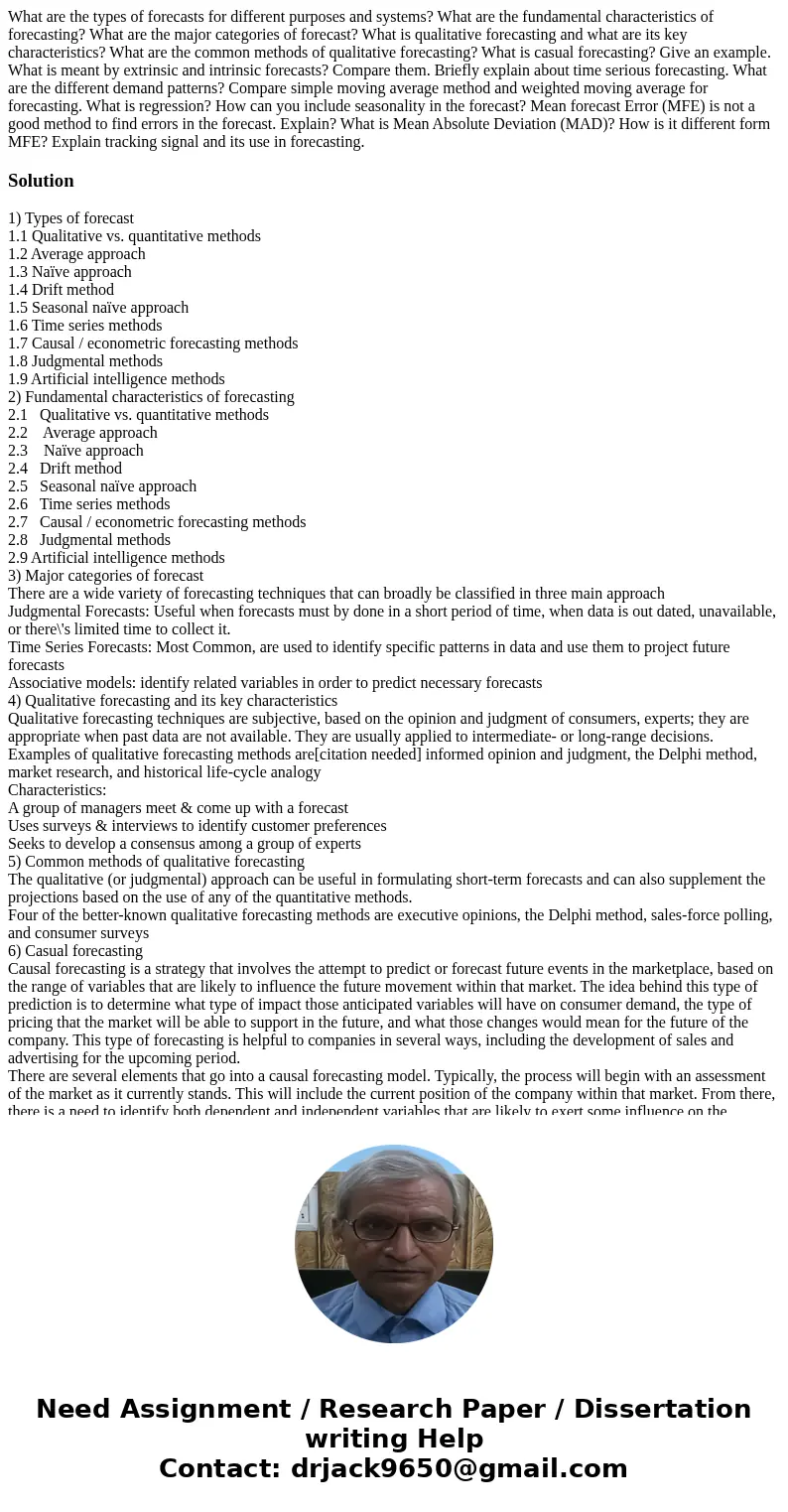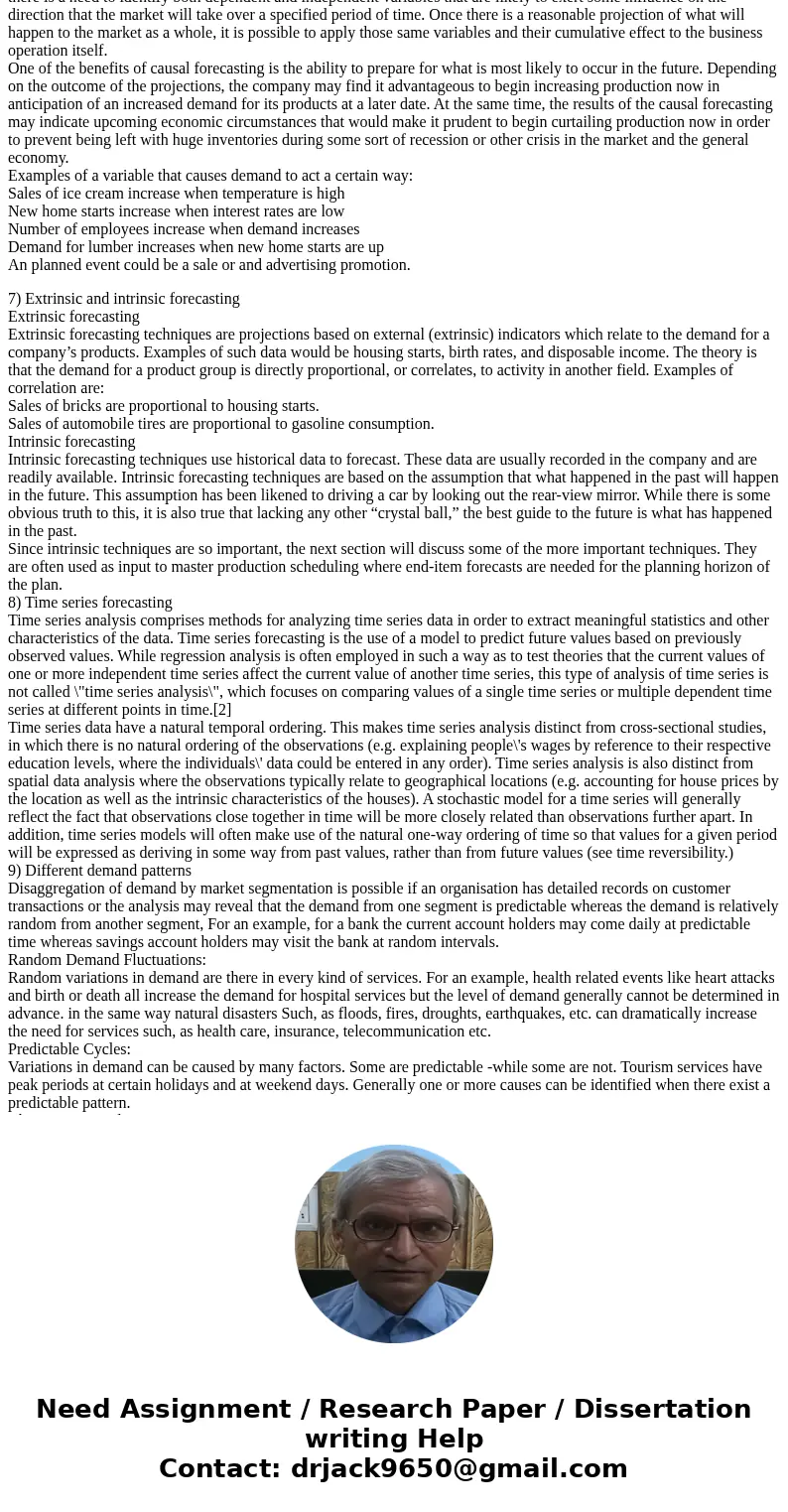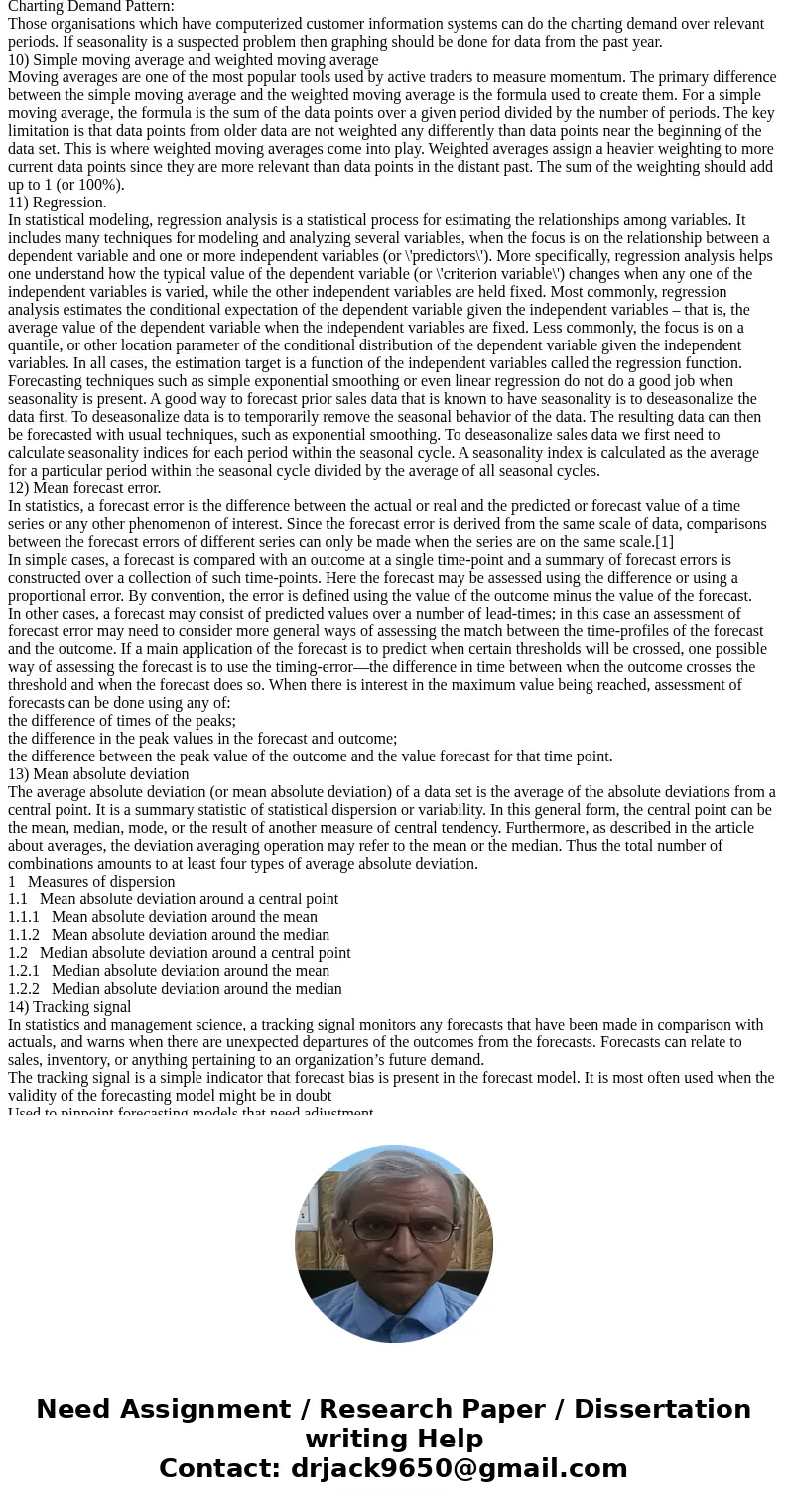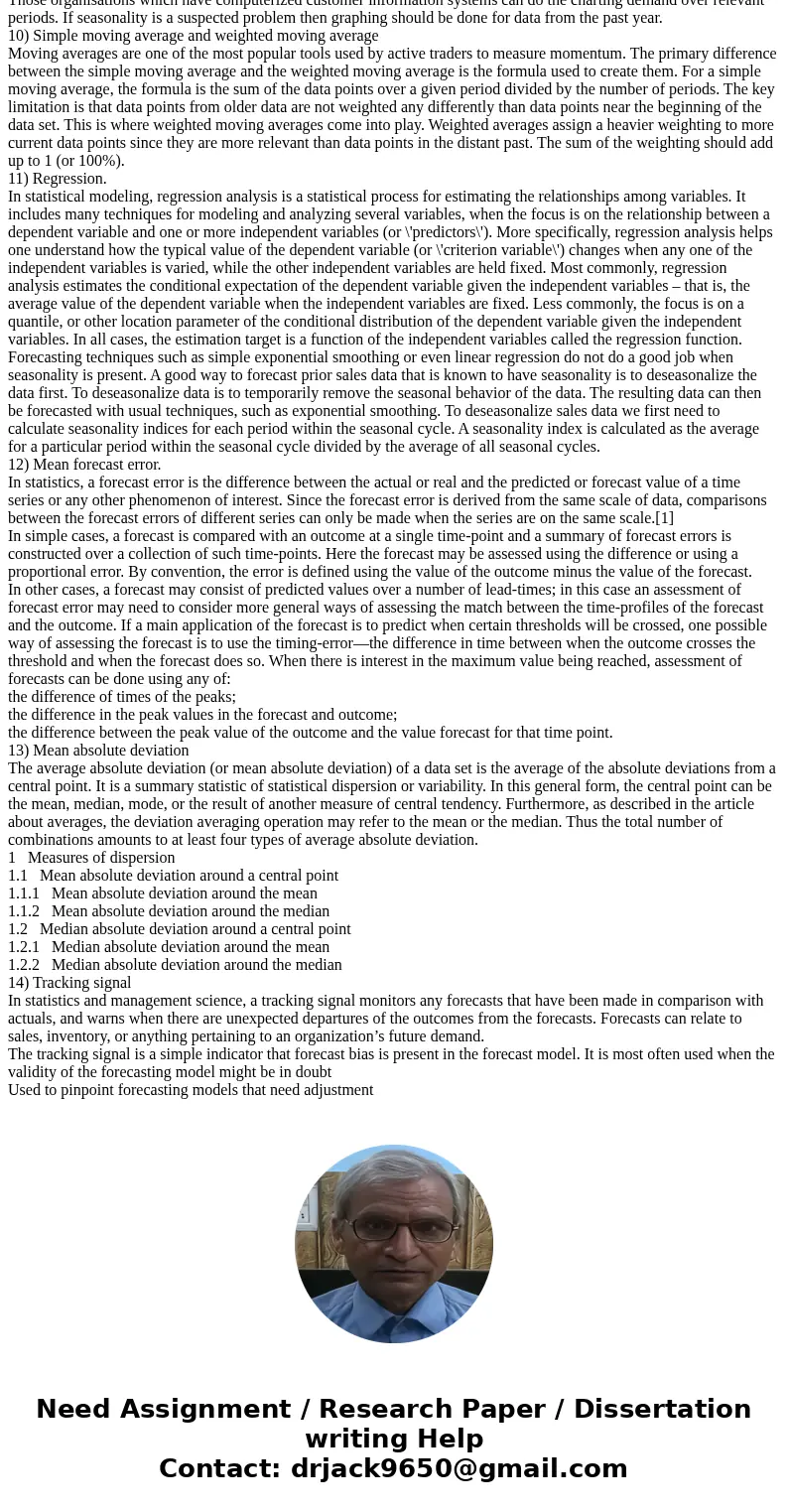What are the types of forecasts for different purposes and s
Solution
1) Types of forecast
1.1 Qualitative vs. quantitative methods
1.2 Average approach
1.3 Naïve approach
1.4 Drift method
1.5 Seasonal naïve approach
1.6 Time series methods
1.7 Causal / econometric forecasting methods
1.8 Judgmental methods
1.9 Artificial intelligence methods
2) Fundamental characteristics of forecasting
2.1 Qualitative vs. quantitative methods
2.2 Average approach
2.3 Naïve approach
2.4 Drift method
2.5 Seasonal naïve approach
2.6 Time series methods
2.7 Causal / econometric forecasting methods
2.8 Judgmental methods
2.9 Artificial intelligence methods
3) Major categories of forecast
There are a wide variety of forecasting techniques that can broadly be classified in three main approach
Judgmental Forecasts: Useful when forecasts must by done in a short period of time, when data is out dated, unavailable, or there\'s limited time to collect it.
Time Series Forecasts: Most Common, are used to identify specific patterns in data and use them to project future forecasts
Associative models: identify related variables in order to predict necessary forecasts
4) Qualitative forecasting and its key characteristics
Qualitative forecasting techniques are subjective, based on the opinion and judgment of consumers, experts; they are appropriate when past data are not available. They are usually applied to intermediate- or long-range decisions. Examples of qualitative forecasting methods are[citation needed] informed opinion and judgment, the Delphi method, market research, and historical life-cycle analogy
Characteristics:
A group of managers meet & come up with a forecast
Uses surveys & interviews to identify customer preferences
Seeks to develop a consensus among a group of experts
5) Common methods of qualitative forecasting
The qualitative (or judgmental) approach can be useful in formulating short-term forecasts and can also supplement the projections based on the use of any of the quantitative methods.
Four of the better-known qualitative forecasting methods are executive opinions, the Delphi method, sales-force polling, and consumer surveys
6) Casual forecasting
Causal forecasting is a strategy that involves the attempt to predict or forecast future events in the marketplace, based on the range of variables that are likely to influence the future movement within that market. The idea behind this type of prediction is to determine what type of impact those anticipated variables will have on consumer demand, the type of pricing that the market will be able to support in the future, and what those changes would mean for the future of the company. This type of forecasting is helpful to companies in several ways, including the development of sales and advertising for the upcoming period.
There are several elements that go into a causal forecasting model. Typically, the process will begin with an assessment of the market as it currently stands. This will include the current position of the company within that market. From there, there is a need to identify both dependent and independent variables that are likely to exert some influence on the direction that the market will take over a specified period of time. Once there is a reasonable projection of what will happen to the market as a whole, it is possible to apply those same variables and their cumulative effect to the business operation itself.
One of the benefits of causal forecasting is the ability to prepare for what is most likely to occur in the future. Depending on the outcome of the projections, the company may find it advantageous to begin increasing production now in anticipation of an increased demand for its products at a later date. At the same time, the results of the causal forecasting may indicate upcoming economic circumstances that would make it prudent to begin curtailing production now in order to prevent being left with huge inventories during some sort of recession or other crisis in the market and the general economy.
Examples of a variable that causes demand to act a certain way:
Sales of ice cream increase when temperature is high
New home starts increase when interest rates are low
Number of employees increase when demand increases
Demand for lumber increases when new home starts are up
An planned event could be a sale or and advertising promotion.
7) Extrinsic and intrinsic forecasting
Extrinsic forecasting
Extrinsic forecasting techniques are projections based on external (extrinsic) indicators which relate to the demand for a company’s products. Examples of such data would be housing starts, birth rates, and disposable income. The theory is that the demand for a product group is directly proportional, or correlates, to activity in another field. Examples of correlation are:
Sales of bricks are proportional to housing starts.
Sales of automobile tires are proportional to gasoline consumption.
Intrinsic forecasting
Intrinsic forecasting techniques use historical data to forecast. These data are usually recorded in the company and are readily available. Intrinsic forecasting techniques are based on the assumption that what happened in the past will happen in the future. This assumption has been likened to driving a car by looking out the rear-view mirror. While there is some obvious truth to this, it is also true that lacking any other “crystal ball,” the best guide to the future is what has happened in the past.
Since intrinsic techniques are so important, the next section will discuss some of the more important techniques. They are often used as input to master production scheduling where end-item forecasts are needed for the planning horizon of the plan.
8) Time series forecasting
Time series analysis comprises methods for analyzing time series data in order to extract meaningful statistics and other characteristics of the data. Time series forecasting is the use of a model to predict future values based on previously observed values. While regression analysis is often employed in such a way as to test theories that the current values of one or more independent time series affect the current value of another time series, this type of analysis of time series is not called \"time series analysis\", which focuses on comparing values of a single time series or multiple dependent time series at different points in time.[2]
Time series data have a natural temporal ordering. This makes time series analysis distinct from cross-sectional studies, in which there is no natural ordering of the observations (e.g. explaining people\'s wages by reference to their respective education levels, where the individuals\' data could be entered in any order). Time series analysis is also distinct from spatial data analysis where the observations typically relate to geographical locations (e.g. accounting for house prices by the location as well as the intrinsic characteristics of the houses). A stochastic model for a time series will generally reflect the fact that observations close together in time will be more closely related than observations further apart. In addition, time series models will often make use of the natural one-way ordering of time so that values for a given period will be expressed as deriving in some way from past values, rather than from future values (see time reversibility.)
9) Different demand patterns
Disaggregation of demand by market segmentation is possible if an organisation has detailed records on customer transactions or the analysis may reveal that the demand from one segment is predictable whereas the demand is relatively random from another segment, For an example, for a bank the current account holders may come daily at predictable time whereas savings account holders may visit the bank at random intervals.
Random Demand Fluctuations:
Random variations in demand are there in every kind of services. For an example, health related events like heart attacks and birth or death all increase the demand for hospital services but the level of demand generally cannot be determined in advance. in the same way natural disasters Such, as floods, fires, droughts, earthquakes, etc. can dramatically increase the need for services such, as health care, insurance, telecommunication etc.
Predictable Cycles:
Variations in demand can be caused by many factors. Some are predictable -while some are not. Tourism services have peak periods at certain holidays and at weekend days. Generally one or more causes can be identified when there exist a predictable pattern.
Charting Demand Pattern:
Those organisations which have computerized customer information systems can do the charting demand over relevant periods. If seasonality is a suspected problem then graphing should be done for data from the past year.
10) Simple moving average and weighted moving average
Moving averages are one of the most popular tools used by active traders to measure momentum. The primary difference between the simple moving average and the weighted moving average is the formula used to create them. For a simple moving average, the formula is the sum of the data points over a given period divided by the number of periods. The key limitation is that data points from older data are not weighted any differently than data points near the beginning of the data set. This is where weighted moving averages come into play. Weighted averages assign a heavier weighting to more current data points since they are more relevant than data points in the distant past. The sum of the weighting should add up to 1 (or 100%).
11) Regression.
In statistical modeling, regression analysis is a statistical process for estimating the relationships among variables. It includes many techniques for modeling and analyzing several variables, when the focus is on the relationship between a dependent variable and one or more independent variables (or \'predictors\'). More specifically, regression analysis helps one understand how the typical value of the dependent variable (or \'criterion variable\') changes when any one of the independent variables is varied, while the other independent variables are held fixed. Most commonly, regression analysis estimates the conditional expectation of the dependent variable given the independent variables – that is, the average value of the dependent variable when the independent variables are fixed. Less commonly, the focus is on a quantile, or other location parameter of the conditional distribution of the dependent variable given the independent variables. In all cases, the estimation target is a function of the independent variables called the regression function.
Forecasting techniques such as simple exponential smoothing or even linear regression do not do a good job when seasonality is present. A good way to forecast prior sales data that is known to have seasonality is to deseasonalize the data first. To deseasonalize data is to temporarily remove the seasonal behavior of the data. The resulting data can then be forecasted with usual techniques, such as exponential smoothing. To deseasonalize sales data we first need to calculate seasonality indices for each period within the seasonal cycle. A seasonality index is calculated as the average for a particular period within the seasonal cycle divided by the average of all seasonal cycles.
12) Mean forecast error.
In statistics, a forecast error is the difference between the actual or real and the predicted or forecast value of a time series or any other phenomenon of interest. Since the forecast error is derived from the same scale of data, comparisons between the forecast errors of different series can only be made when the series are on the same scale.[1]
In simple cases, a forecast is compared with an outcome at a single time-point and a summary of forecast errors is constructed over a collection of such time-points. Here the forecast may be assessed using the difference or using a proportional error. By convention, the error is defined using the value of the outcome minus the value of the forecast.
In other cases, a forecast may consist of predicted values over a number of lead-times; in this case an assessment of forecast error may need to consider more general ways of assessing the match between the time-profiles of the forecast and the outcome. If a main application of the forecast is to predict when certain thresholds will be crossed, one possible way of assessing the forecast is to use the timing-error—the difference in time between when the outcome crosses the threshold and when the forecast does so. When there is interest in the maximum value being reached, assessment of forecasts can be done using any of:
the difference of times of the peaks;
the difference in the peak values in the forecast and outcome;
the difference between the peak value of the outcome and the value forecast for that time point.
13) Mean absolute deviation
The average absolute deviation (or mean absolute deviation) of a data set is the average of the absolute deviations from a central point. It is a summary statistic of statistical dispersion or variability. In this general form, the central point can be the mean, median, mode, or the result of another measure of central tendency. Furthermore, as described in the article about averages, the deviation averaging operation may refer to the mean or the median. Thus the total number of combinations amounts to at least four types of average absolute deviation.
1 Measures of dispersion
1.1 Mean absolute deviation around a central point
1.1.1 Mean absolute deviation around the mean
1.1.2 Mean absolute deviation around the median
1.2 Median absolute deviation around a central point
1.2.1 Median absolute deviation around the mean
1.2.2 Median absolute deviation around the median
14) Tracking signal
In statistics and management science, a tracking signal monitors any forecasts that have been made in comparison with actuals, and warns when there are unexpected departures of the outcomes from the forecasts. Forecasts can relate to sales, inventory, or anything pertaining to an organization’s future demand.
The tracking signal is a simple indicator that forecast bias is present in the forecast model. It is most often used when the validity of the forecasting model might be in doubt
Used to pinpoint forecasting models that need adjustment




 Homework Sourse
Homework Sourse